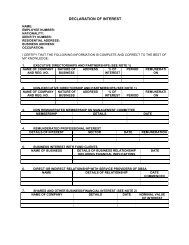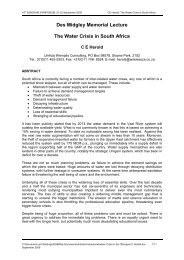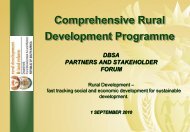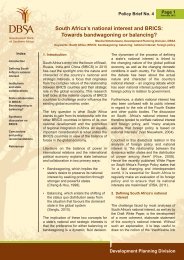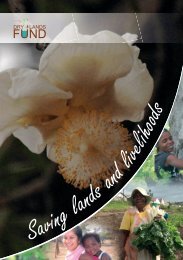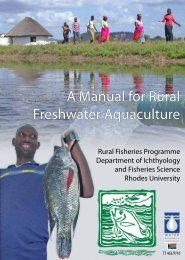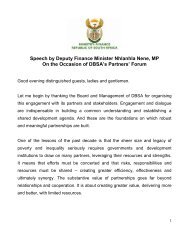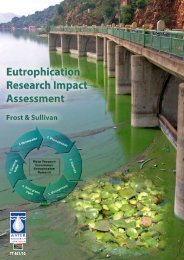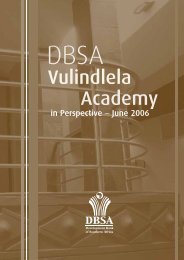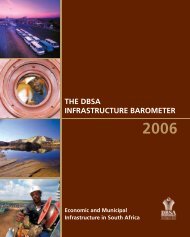Are Hernando de Soto's views appropriate to South Africa?
Are Hernando de Soto's views appropriate to South Africa?
Are Hernando de Soto's views appropriate to South Africa?
Create successful ePaper yourself
Turn your PDF publications into a flip-book with our unique Google optimized e-Paper software.
Lauren Roys<strong>to</strong>n<br />
against <strong>de</strong> So<strong>to</strong>’s bridge-building hypothesis (Roys<strong>to</strong>n 2006). I will briefly recall the<br />
main arguments here.<br />
Upon examination, linking title <strong>to</strong> access <strong>to</strong> credit and the maintenance of formal<br />
property ownership by the poor turn out <strong>to</strong> be faulty assumptions. And even if they<br />
s<strong>to</strong>od on firmer ground, legal integration is a complex task that will take consi<strong>de</strong>rable<br />
time <strong>to</strong> achieve, as <strong>de</strong> So<strong>to</strong> himself acknowledges.<br />
The housing subsidy<br />
and the provision of<br />
free basic services<br />
are <strong>South</strong> <strong>Africa</strong>n<br />
examples of the<br />
asset protection or<br />
safety net approach<br />
There is great <strong>de</strong>al more myth than mystery in the access-<strong>to</strong>-credit claim. Len<strong>de</strong>rs<br />
don’t lend <strong>to</strong> the poor; if they did, it would be risky for the poor; and in cases where<br />
credit is exten<strong>de</strong>d <strong>to</strong> the poor, formal title does not appear <strong>to</strong> be a precondition.<br />
Access <strong>to</strong> credit alone is not enough <strong>to</strong> elevate the poor out of poverty, and is<br />
not sustainable on its own because there are fac<strong>to</strong>rs other than the lack of title<br />
that prevent the poor from entering the market in the first place. Unfortunately,<br />
poverty is more complex than the lack of formal title. I have argued that <strong>de</strong> So<strong>to</strong>’s<br />
analysis lacks the political-economic consi<strong>de</strong>ration of whose interests are served by<br />
maintaining the status quo, which makes the prospect of successfully introducing the<br />
legal reforms required for a more <strong>appropriate</strong>, accessible and sustainable property<br />
system highly unlikely. There is little recognition of the realities of power relations<br />
and political imperatives; and if these aspects are not successfully <strong>de</strong>alt with, the<br />
chances of formalising the property rights for the poor – a seemingly simple and<br />
standardised solution – are exceedingly slim. In addition, sustainining access <strong>to</strong> title<br />
and capital is at least as important as gaining it in the first place – and what often<br />
happens in practice is that as soon as formal systems are applied <strong>to</strong> informal and<br />
especially communal areas, they break down (Leap 2004).<br />
These two points – about the risks associated with using property as collateral, and<br />
the reality of reversion – call in<strong>to</strong> question the bridge-building hypothesis. The<br />
poor are not a homogenous group in possession of assets that can uniformly be<br />
<strong>de</strong>scribed as ‘<strong>de</strong>ad capital’. Land functions in various ways, which the notions of use<br />
and exchange value <strong>de</strong>note, and the concept of <strong>de</strong>ad capital is of limited value in<br />
more informal contexts.<br />
The trampoline<br />
The metaphor of the trampoline comes from ‘third way’ thinking about the failures<br />
of the welfare state <strong>to</strong> combat poverty and reduce income inequality, as espoused<br />
by Anthony Gid<strong>de</strong>ns in his book with the same name (The Third Way, 2002) and<br />
embraced by the former British prime minister Tony Blair. In short, the hypothesis<br />
is that by removing the safety net (the welfare state) and bringing in the trampoline<br />
(the third way), the poor can ‘bounce’ themselves out of poverty. The link with <strong>de</strong><br />
So<strong>to</strong>, AsgiSA, and the housing policy discourse in <strong>South</strong> <strong>Africa</strong> lies in the treatment<br />
of assets.<br />
A welfare approach emphasises asset protection (‘the net’), and risk prevention and<br />
mitigation in or<strong>de</strong>r <strong>to</strong> protect the poor and vulnerable against fac<strong>to</strong>rs threatening<br />
the erosion of their assets. The ‘third way’ approach emphasises asset accumulation<br />
38



